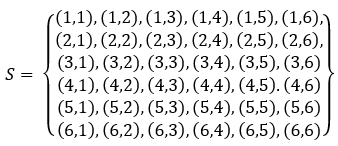An experiment involves rolling a pair of dice and recording the numbers that come up. Describe the following events:
A: the sum is greater than 8,
B: 2 occurs on either die
C: the sum is at least 7 and a multiple of 3.
Which pairs of these events are mutually exclusive?
Since a pair of dice is thrown, all the possible outcomes or sample space (S) will be as follows

A: the sum is greater than 8
Possible sum greater than 8 are 9, 10, 11 & 12
∴ A= ![]()
B: 2 occurs on either die
Here possibilities are there that the number 2 will come on first die or second die or both the die simultaneously
B= ![]()
C: The sum is at least 7 and multiple of 3
So the sum can be only 9 or 12
C= ![]()
For 2 elements to be mutually exclusive, then there should not be any common element amongst them
(i) A∩ B =ϕ
As there is no common element in A and B
So A& B are mutually exclusive
(ii) B ∩ C = ϕ
Since there is no common element between
So B and C are mutually exclusive.
(iii) A ∩ C
⇒ ![]() ≠ ϕ
≠ ϕ
Since A and C has common elements,
∴ A and C are mutually exclusive.